By Jean Huon
Before the end of WWI, French headquarters realized that the armament of the infantry was obsolete and looked for a quick replacement. At the end of the war, the French government was interested in modern small arms such as the model used by American troops. First, the BAR automatic rifle was adopted on October 16, 1918. Five thousand of these were ordered, and .30-06 cartridges were to be produced in France. But four days later, the order was canceled by General Pétain, the same man who required more modern equipment the year before!
The Manufacture d’Armes de Saint-Etienne (MAS factory) developed a copy of the Ruby pistol with a longer barrel (never produced). In Châtellerault, the Manufacture d’Armes de Châtellerault (MAC factory) manufactured some 3,160 Vickers Mark II aircraft machine guns, between October 1918 and July 1919.
Private factories also proposed new weapons:
- Delaunay-Belleville (a car manufacturer) developed an automatic gas-actuated carbine with a very complicated recoil spring in the stock;
- Darne, a small arms factory in Saint-Etienne, produced under license 3,266 Lewis Light machine guns (LMGs) for the Air Force and developed a new machine gun, 1,000 of which were ordered. After the end of the war this order was turned into six different types of weapons, chambered in three calibers;
Gladiator was the manufacturer of the Chauchat Light machine gun (247,944 produced) and proposed several automatic small arms designed by Paul Ribeyrolles: a firing port weapon for tanks drawn from an M1917 semi-automatic rifle and also an automatic carbine shooting the first intermediate cartridge ever made.
The 1921 Program
In May 1920, General Duval, chief of the infantry weapons board said that the production of the BAR rifle and its “special” cartridges was absolutely necessary. On May 21, 1921, the artillery headquarters published a very ambitious program meant to replace all individual or collective small arms. All models were concerned, and all the French state-owned and private factories were asked to compete.
Among all the projects, only one was quickly realized: the Châtellerault LMG. The others dragged along miserably for 15 years or more, for various reasons:
- Hesitation of the Army, which changed programs several times;
- Lack of money (already?); and
- Political unrest, disorganization and nationalization of all private armament and aircraft factories after the election of the “Front Populaire” government (socialist and communist) in 1936.
The initial military programs described a submachine gun looking like a small carbine, weighing between 3kg and 4kg (6.6 pounds to 8.8 pounds). The cartridge was to be the same for the pistol. Before an eventual new choice, it was to shoot the 9mm Luger cartridge. The magazine was to hold 25 shots at least, and the gun was to have a selector. At first, a bipod was required, but it became optional later.
On July 9, 1926, the program was revised with new specifications:
- The cartridge was to be the .30 Pedersen long cartridge (it later became the 7.65mm Long);
- Weight 2.6kg (5.7 pounds);
- 32-round magazine;
- Cyclic rate 400rpm to 500rpm;
- Selector;
- Accuracy: shooting burst in a 27.6-inch square target at 110 yards; and
- Two sights (150m and 250m).
The document was signed by General Rémond, Chief of the Artillery Board.
The C.E.I. SMG
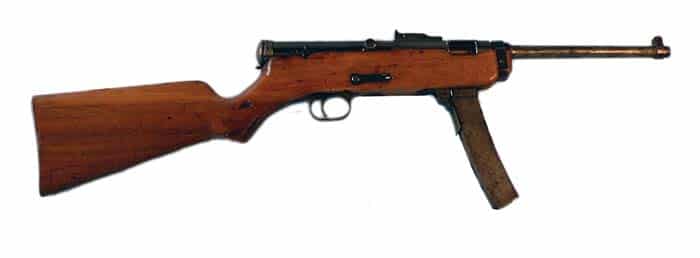
CEI No. 2 SMG.
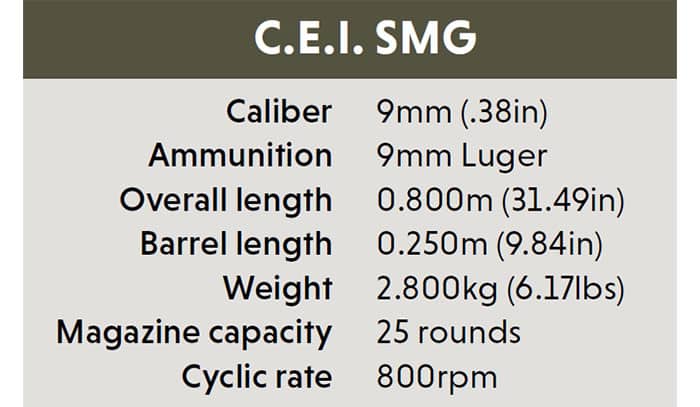
Before the publication of the M1921 program, the “Commission d’ Experience de l’ Infanterie” (Infantry Ordnance Committee), a subsidiary of the “Section Technique de l’Artillerie” (Artillery Proving Ground) in Satory, near Versailles, realized a 9mm submachine gun. It looked like a small carbine with a wooden stock, tubular cooling sleeve with holes and a selector. It had a curved vertical magazine. It worked with a delayed blow-back bolt associated with a ring and a slanting rail and had an independent firing pin. The rear sight was scaled up to 200m. During proving tests the gun was appreciated for easy handling and simplicity. Field stripping was easy, and it worked correctly, with the exception of some case ejection troubles.
Developed before the M1921 program, the designers were invited to improve it. A new model designed C.E.I. No. 2 was presented in June 1922. Its barrel was longer, without a sleeve, and the ejection port had a door.
The STA 1924
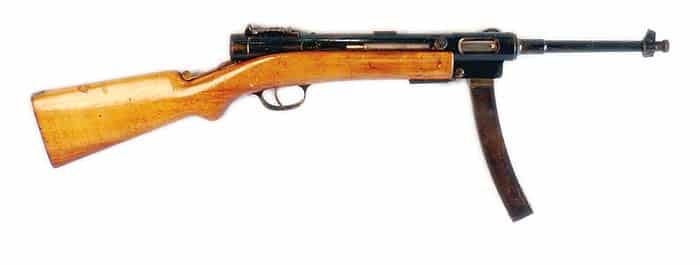
The STA 1924

Up to 1919, the workshop of the “Section Technique de l’Artillerie” (Artillery Proving Ground), located in Paris in the former Saint Thomas d’Aquin monastery, developed a submachine gun. The first prototype was ready in October 1921. It was improved in 1922, and eight other prototypes were manufactured.
The magazines were produced by MAC in Châtellerault, and their design was similar to the Revelli SMG magazines. Three hundred were manufactured by MAS in Saint-Etienne to be field tested by troops. The SMG was adopted on August 11, 1925, and 8,250 were ordered. But they were never produced because the program was altered, and the career of the STA 1924 stopped at this point. Some were used by the French Army during the Rif War in Morocco, since 210 of them were sent to the Artillery arsenal in Casablanca.
The STA 1924 looks like a small carbine, and the organization is similar to the Ribeyrolles automatic carbine with a tubular frame, a sleeve with the magazine housing and the ejection port. The bolt is similar to the one of the MP 18,I with an independent firing pin fixed on a linear hammer. The cocking lever on the right side has the shape of a hook.
The barrel, a 9mm (.38-inch) caliber, is screwed into the frame with six grooves with a right hand twist. The gun receives a curved box magazine of 32 rounds on two stacks. Magazine lips allow an alternative feeding. The rear sight wears an aperture for shooting from 100m to 600m.
The MAC SMG
In 1924-1925, the Châtellerault small arms factory developed a submachine gun that worked with a tilting bolt similar to the one of the M1924 LMG, but the project was discarded.
The MAS SMG
From 1924 to 1935, the research board of Saint-Etienne small arms factory developed several models of submachine guns.
Type 1 and Type 1 Bis
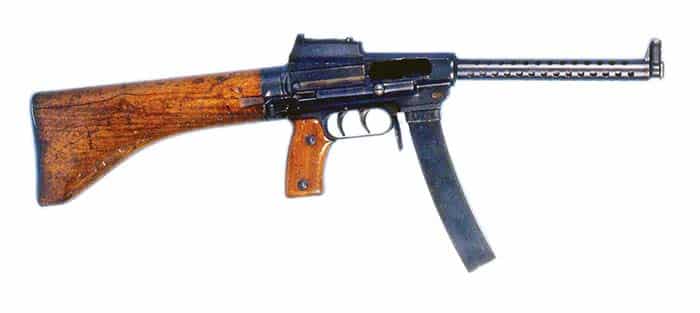
MAS S.E. MAS Type 1 SMG.
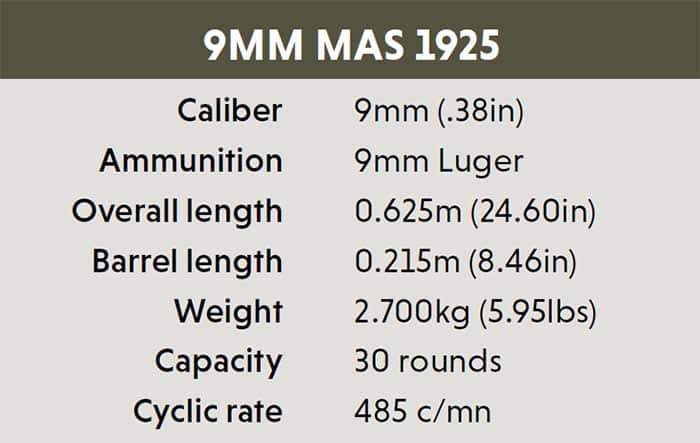
The S.E. MAS Type 1 SMG looks already like the future MAS 38 with a barrel 6 degrees out of the line axis of the frame. It has a tangent rear sight which allowed shooting up to 600m. Two triggers allow single-shot or burst. A folding door enables the closing of the feeding port.
Type 1 Bis has a cocking handle fixed on a sliding closing door of the ejection port. It has also a perforated sleeve around the barrel. Sights are higher for shooting above the cooling sleeve. Both models fired the 9mm Luger round. Tests began in December 1924. Two other models in caliber 7.65mm Long were manufactured in August 1925, with a single trigger and a folding rear sight. They were not as accurate as the STA 1924 SMG.
Type 2 (or S.E. MAS 1925)
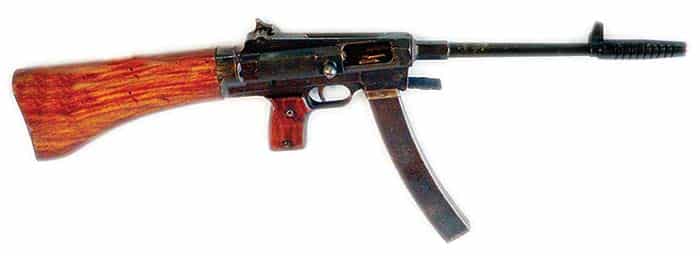
MAS 1925 SMG.

New models were made, both in 9mm and 7.65mm. The cooling sleeve was discarded. The single-shot trigger disappeared, and the sight had four leaves. A compensator was put on the 9mm prototype. After field tests, the model that fired the 7.65mm Long cartridge was selected, but some improvements were needed.
Type 3
Type 3 is a variation with a barrel lined up with the frame. It has also a device to reduce the cyclic rate.
S.E. MAS 31
It is an evolution of the MAS 1925 with two triggers.
S.E. MAS 1934
This is an automatic carbine, different from the previous models.
S.E. MAS 1935
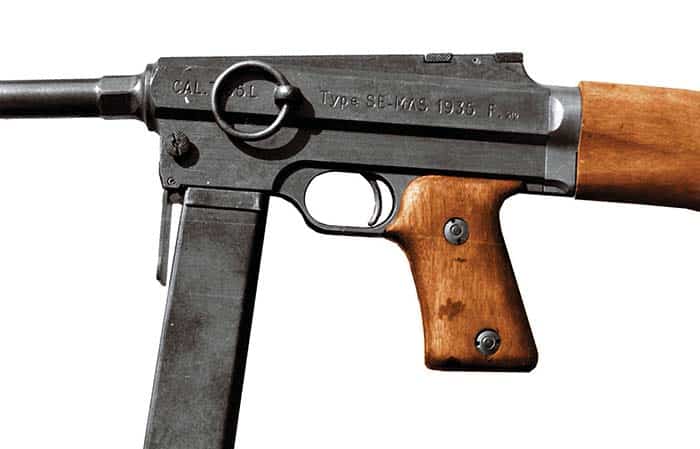
Marks on S.E. MAS 1935.
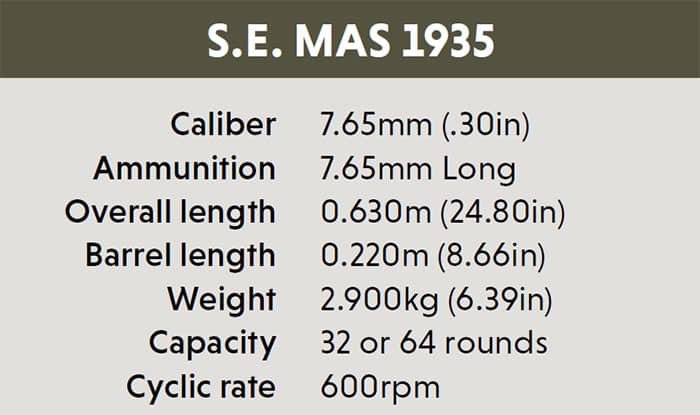
Evolution of the S.E. MAS 1931 with:
- A bolt having a fixed firing pin;
- A barrel 5° out of line from the frame (instead of 6° before);
- A magazine not exactly vertical, but with a 9° angle (instead of 12° before);
- A rear sight with two independent leaves; and
- Some other details.
Only several hundred were made for field tests. It was adopted on May 9, 1940, as the MAS 1938, and 19,500 were ordered, but on June 23, 1940, only 1,958 were delivered. Some S.E. MAS 35s and MAS 38s were used against German troops in May and June 1940.
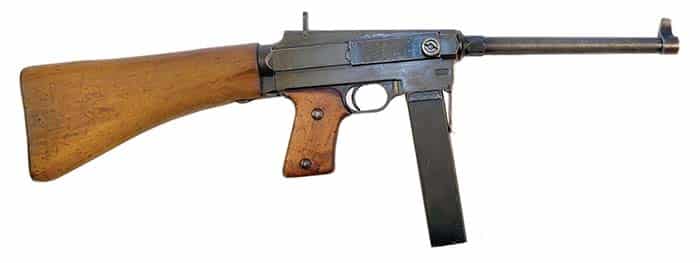
MAS 1938 SMG.
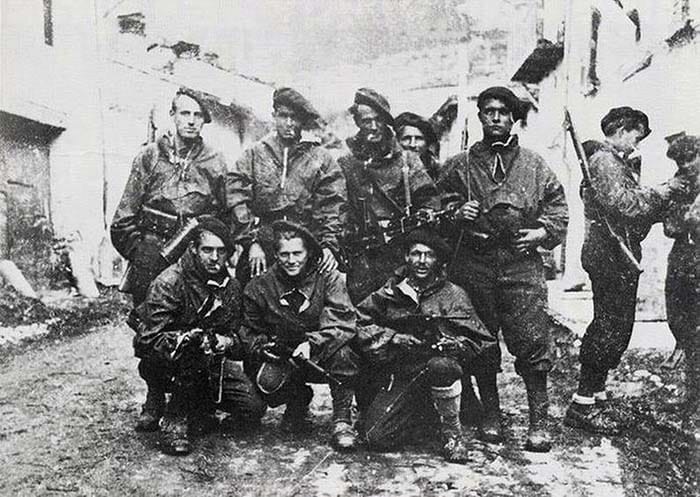
The E.T.V.S. SMG
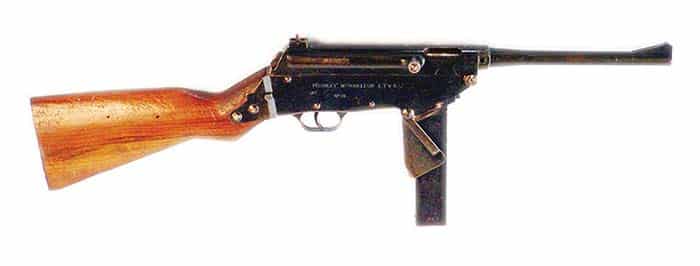
E.T.V.S. 1938 SMG.
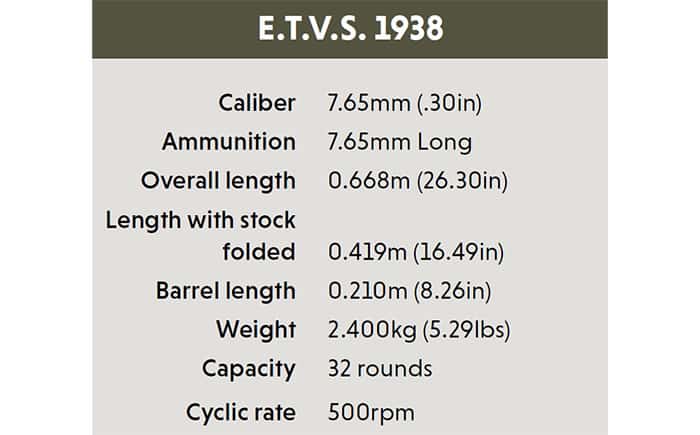
To fill a request filed from tank crews in 1933, a small-sized submachine gun with a folding stock and magazine was planned. At this time, only the MAS prototypes were available, but its organization with a recoil spring inside the stock did not allow a modification.
The “Commission d’Expériences de Versailles” (Infantry Ordnance Committee) decided to manufacture its own model, which was tested in 1936. Designed by Captain Martin, it is a small carbine with a short forearm and pistol grip. The cylindrical frame had a bolt with a cocking handle on the right. The barrel has a truncated shape with a compensator at the muzzle, under the front sight.
The C.E.V. SMG was improved, and a new version was presented on January 14, 1938. It was designated the E.T.V.S. SMG (Etablissement Technique de Versailles). Several parts broke down, and the gun was returned twice for repairs. New tests were made on April 1938.
It had a blow-back bolt, with a reducer using a rotating wheel. The stock and magazine could be folded. The SMG had excellent results during the trials in June 1939, and the Châtellerault small arms factory was selected to manufacture 100 of them, but the destiny of this gun was doomed in the following storm.
The Petter Model
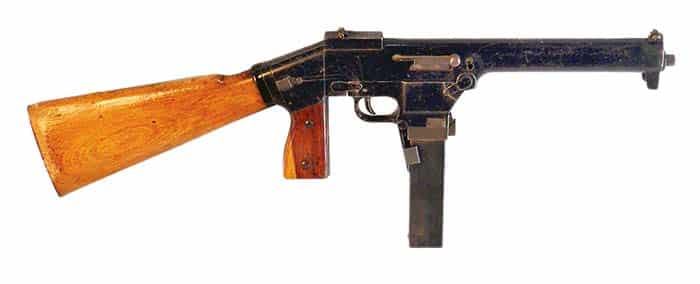
Petter SMG.
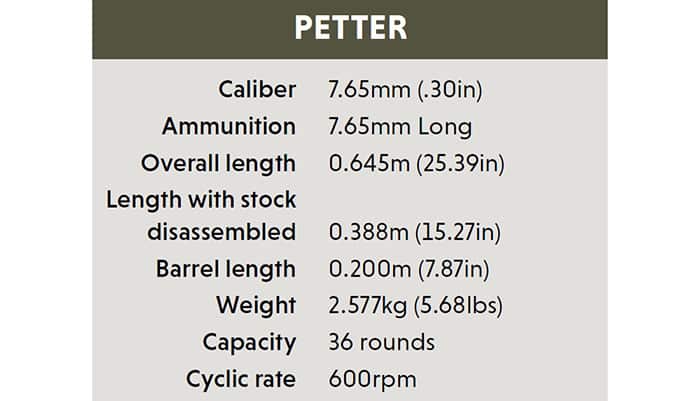
Charles Petter, a Swiss engineer and former manager of the “Société des Armes Lewis,” was the designer of the French M1935A pistol, adopted in 1937 and manufactured by the “Société Alsacienne de Constructions Mécaniques” in Cholet. He also made a submachine gun covered by French patent No. 170.021 requested on November 30, 1936, and U.S. Patent No. 2.154.770 requested on April 18, 1939, and delivered on October 20, 1940. The patents concerned the regulator device. Several models were tested in 1936, and 50 such weapons were manufactured for field trials. Some of them were used during the 1940 campaign.
The Petter SMG is a light and compact model, with a triangular wooden stock which could be easily dismounted. The frame has a sleeve around the barrel. The SMG has several interesting features:
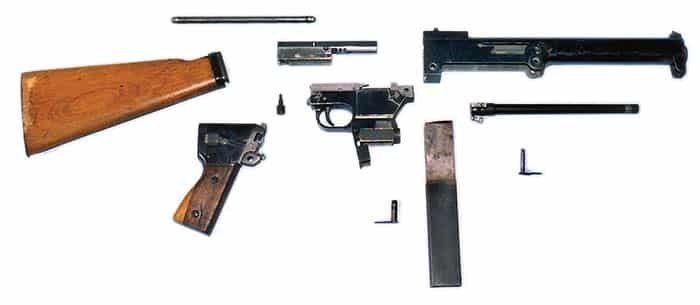
- Short recoil action;
- No selector;
- The bolt is made of a prismatic block with an upper recess with a housing for the recoil spring and locking lugs;
- It is associated with a reducer, made by the association of a rod, a fluctuating block, automatic trigger and spiral spring;
- Folding magazine.
French Submachine Guns in 1939–1940
After 20 years of research and hesitation, how many submachine guns were in use within the French Army at the beginning of WWII? The result is near zero!
Quickly, the high command was convinced that this equipment became necessary, especially for the Special Forces waging night operations in the “No Man’s Land” in front of the Maginot line, named “Corps Francs.”
At first they used the Châtellerault LMG M1924-29, and all the few submachine guns available:
- Experimental weapons tested before the war: STA 1924, S.E. MAS 1935, E.T.V.S., Petter;
- 3,000 Thompson M1921 and M1928A1—ordered in a hurry in the U.S., only a few arrived before the armistice and probably none of them were used.

The Ribeyrolles 1918 submachine gun was a firing port weapon for tanks.
Another supply source was also used: Submachine guns of the Spanish Republican soldiers arrived in France in 1939 after the “Retirada.” Those shooting the 9mm Largo cartridges were discarded; only those firing the 9mm Luger cartridge were kept (Schmeisser, Steyr-Mannlicher, MP 34, Tallinn, Suomi, FAI, etc.), but their disparity and the lack of magazines prevented the use of all these weapons. Only 3,250 Vollmer Erma SMGs could be used but only 1,540 magazines were available. The research of manufacturers in France or in Switzerland was unsuccessful. Only 700 to 800 Vollmer Erma SMGs could be used.
Other proposals were made:
- Deliveries of Beretta M1938 SMGs by the Italians on May 17, 1940 (they were to declare war on June 10);
- Production of 7.65mm Long Star S.I. 35 in Spain.
But it was too late.
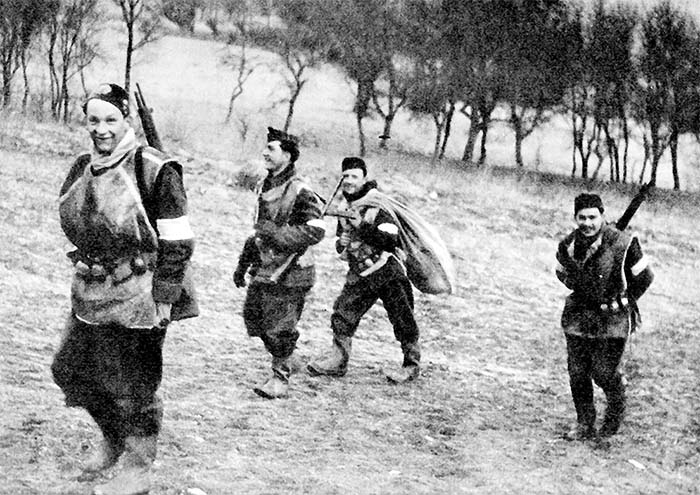
| This article first appeared in Small Arms Review V23N4 (April 2019) |











